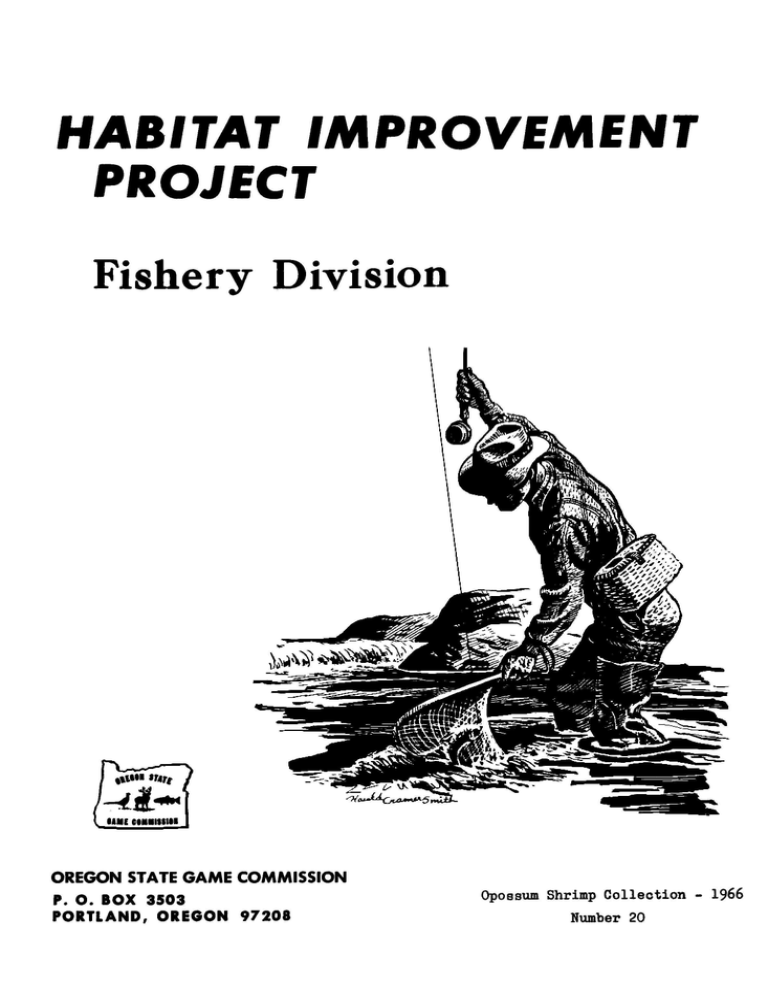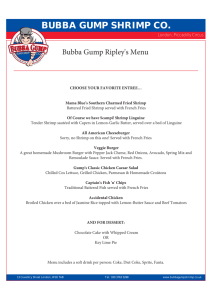HABITAT IMPROVEMENT Fishery Division PROJECT P. 0. BOX 3503
advertisement

HABITAT IMPROVEMENT PROJECT Fishery Division 0On trace ".4.11.4$414 UME CONOISSIIII OREGON STATE GAME COMMISSION P. 0. BOX 3503 PORTLAND, OREGON 97208 Opossum Shrimp Collection - 1966 Number 20 STATE OF OREGON OREGON STATE GAME COMMISSION FISHERY DIVISION C. J. Campbell, Chief of Operations Opossum Shrimp Collection Federal Aid to Fish Restoration Project Project F-76-D-2 By Wendell H. Stout and Ralph A. Grenfell District Aquatic Biologists Opossum Shrimp Collection - 1966 Number 20 This page intentionally left blank OPOSSUM SHRIMP COLLECTION ABSTRACT Opossum shrimp Mysis relicta were collected in Upper Waterton Lake, Alberta, Canada, in the summer of 1966 for the second successive year. Approximately 650,000 were collected and introduced into Waldo, Wallowa, Big Cultus, Crescent, and Timothy Lakes in Oregon. INTRODUCTION The introduction of Mysis relicts, the opossum shrimp, to Oregon lakes was continued in 1966 as a follow-up of the initial transplants made a year earlier and reported by Sayre and Stout (1965). Approximately 650,000 shrimp were col- lected from Upper Waterton Lake, Alberta, Canada, in 1966 and distributed to Wallowa, Waldo, Big Cultus, Crescent, and Timothy Lakes in Oregon. The purpose of the introduction is to improve the fish-producing capacity of these oligotrophic waters. METHODS Collections Trawling operations to capture shrimp were begun on August 11, 1966 and terminated on August 24. Collections were made in the north end of Upper Waterton Lake and in Emerald Bay next to the townsite. Large concentrations of shrimp were found in both areas at a depth range of from 100 to 200 feet. Figures 1 and 2 depict the lake and trawling areas. Gear employed to capture the shrimp was the same as used in 1965, except that an electric winch was substituted for the slow and tiresome hand winch. was mounted in a rigid tubular frame so its mouth was held open. The net The lower lip of the net rode 6 inches off the bottom which minimized the dredging of bottom detritus. The electric winch held 400 feet of 1/8-inch airplane cable. A rigid but socket- ZAN OIL 1. "., CLAt410 LI-I- ??a it ',goer, IC 2 4 41 41+ LMEt 154y WA:rE RT 0 NI AAR. K. b[-LT}[ MT glOswei:L I-11 b cevpr L. 6 01,114 b ie1,41 AG. I ------CAMPOL G LA.CIEZ ...... PAT 0150M wI WATERTON LAKES scow Iss. /mils Figure 2. Figure 3. North end of Upper Waterton Lake, Emerald Bay, and Waterton Townsite where opossum shrimp collection activities were centered in 1966. Boat and trawling rig used during the 1966 opossum shrimp collections. 4 mounted steel boom was used to support the towing cable and net. The boom could be swiveled to allow easier handling of the cod-end of the trawl when removing the shrimp. The average individual trawling time was 5 minutes. The trawling assembly is shown in Figure 3. Mysis were held aboard the boat in well insulated 12-gallon plastic containers, and were given a constant oxygen supply through porous air stones. Hold- ing facilities were provided at the Waterton Park Spring Creek Hatchery in standard hatchery troughs and holding boxes in outdoor raceways. The shrimp were provided with good water circulation and care was taken to protect them from direct light. Transportation With the exception of the final load, all of the 1966 collections were shipped to Oregon by air. The last shipment was made by pickup truck. Mysis were loaded in plastic bags, charged with oxygen, iced, and trucked 40 miles to the airstrip at Babb, Montana. At Babb, the shrimp were repacked in large plastic cans and more ice was added. Oxygen was metered to the shrimp through a cylinder and valve arrangement throughout the flight to Oregon. Upon arrival of the shrimp in Oregon, a variety of methods was employed to transport the shrimp to their final destination. and plastic fish bags were all utilized. Liberation trucks, plastic cans, A fish-planting boat was used at times to distribute the shrimp to the deeper sections of the larger lakes. Counting The number of Mysis collected and distributed was determined by volumetric displacement. An average of 8,200 shrimp was required to displace 100 milli- liters of water. 5 DISCUSSION Distribution On August 18, 240,000 shrimp were put in 20 plastic fish bags with 3 gallons of 45° F. water. The bags were charged with oxygen and sealed, loaded in the truck, iced, and covered for the one-hour drive to the airstrip. At the airplane, the aas were repacked into eight 20-gallon garbage cans with 12 gallons of water and 18 pounds of chlorine-free ice. A trickle system delivered oxygen to each con- tainer through an air stone. The 150,000 shrimp destined for Wallowa Lake, arrived at Joseph, Oregon after a 2.5-hour flight. During the flight the water temperature ranged from 37° to 46° F. At Joseph, the shrimp were transferred to a fish-liberation truck, hauled 45 minutes to the lake, and liberated from a fish-planting boat. The shrimp were tempered in lake water to adjust them to the 69° F. surface temperature. Approximately 20,000 were lost to handling difficulties during the entire transfer. The remaining 90,000 shrimp were flown for another 3 hours to Oregon. Fall River, From there they were transported by truck in the 20-gallon cans to the liberation site at Big Cultus Lake. After 30 minutes tempering, they were released in the 68° F. water. A second aerial shipment was made on August 25, Shipping density was in- creased by distributing the 300,000 shrimp in 15 plastic fish bags. 20,000 shrimp and 3 gallons of water. Each bag held At the airstrip, 3 of the bags, still with the original oxygen charge, were iced and then loaded in a separate compartment in the nose of the airplane. plastic cans. The rest of the load was divided among the 20-gallon Each can held 40,000 Mysis and 15 gallons of water and ice. Oxygen was provided as in previous hauls. After a 4-hour flight, the shrimp were loaded into trucks at Fall River for distribution to Waldo and Crescent Lakes. ranged from 37° to 50° F. Water temperature during the flight 6 Lake surface temperature, at Crescent Lake was stocked with 100,000 shrimp. release of the Mysis was 61° F. face water temperature of 64° F. Waldo Lake received 200,000 shrimp and had a surAt both lakes the water containing the shrimp was tempered to lake water before release. The shrimp hauled in the nose of the airThe craft exhibited little mortality in the 6 hours from loading at Waterton Lake. total loss of shrimp on the second flight was about 10,000 animals. The final load of 110,000 shrimp was transported from Waterton Lake by pickup truck. They were divided evenly in 9 plastic bags, each of which held 3 gallons of water. After charging with oxygen, the bags were iced and sealed, and were then covered with wet burlap and a tarpaulin to exclude heat and light. the shipment was re-oxygenated and iced again. before After 24-hours, A dissolved oxygen sample, taken recharging, showed a concentration of 21 milligrams per liter. Upon arrival at Timothy Lake 30 hours after loading, all the shrimp were alive except for a loss of 12,000 which occurred when a bag ruptured. tempered to the surface water at 64° F. and released. The shrimp were At Timothy Lake, a sample of fifty shrimp was put in a live-box and lowered 35 feet to the thermocline. Dis- solved oxygen concentration at the thermocline was 7.9 milligrams per liter. Twentyfour hours later they were still alive and were released. A small number of shrimp were taken to the Department of Microbiology at Oregon State University where they were examined for the presence of bacterial diseases or parasites. No evidence of either condition was found. Water chemistry and temperature data, for comparison of Waterton Lake and the Oregon lakes, is given in the 1965 Opossum Shrimp Collection Report by Sayre and Stout (1965). Some superficial and unsuccessful attempts have been made to determine the survival of the Mysis introduced in 1965. More thorough investigations to evalu- ate the results of the introductions will be conducted in 1967. 7 ACKNOWLEDGMENTS The splendid courtesy and cooperation extended by the Natural and Historic Resources Branch of the Canada Department of Northern Affairs and Natural Resources contributed substantially to the success of the 1966 opossum shrimp collection operations by the Oregon State Game Commission. Individual thanks are directed to Mr. J. R. B. Coleman, Director; Mr, W. Jo Lunney, Superintendent of Waterton Lake National Park; Mr. Ken Goble, Superintendent of Waterton Park Fish Hatchery; Mr. Art Colbeck, Fishery Technician, Canadian Wildlife Service; and the Warden Service of Waterton Lakes National Park. REFERENCES R. C. Sayre and W. H. Stout. 1965. Opossum Shrimp Collection. Oregon State Game Commission, Fishery Division, Habitat improvement Project (16).







